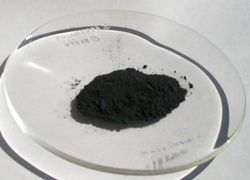Manganese dioxide
 Manganese(IV) oxide
| |
| Names | |
|---|---|
| IUPAC name
Manganese(IV) oxide
| |
| Properties | |
| MnO2 | |
| Molar mass | 86.9368 g/mol |
| Appearance | Black or brown-black solid |
| Odor | Odorless |
| Density | 5.026 g/cm3 |
| Melting point | 535 °C (995 °F; 808 K) (decomposes) |
| Boiling point | Decomposes |
| Insoluble | |
| Solubility | Insoluble in organic solvents |
| Vapor pressure | ~0 mmHg |
| Thermochemistry | |
| Std molar
entropy (S |
53 J·mol−1·K−1 |
| Std enthalpy of
formation (ΔfH |
−520 kJ/mol |
| Hazards | |
| Safety data sheet | Sigma-Aldrich |
| Flash point | Non-flammable |
| Related compounds | |
| Related compounds
|
Manganese heptoxide |
| Except where otherwise noted, data are given for materials in their standard state (at 25 °C [77 °F], 100 kPa). | |
| Infobox references | |
Manganese dioxide is a compound of manganese(IV) with the formula MnO2. It is a common precursor to many manganese compounds, as it is easy to acquire.
Contents
Properties
Chemical
Manganese dioxide is a moderately strong oxidizing agent, and is used as such in the lab. It may be hydrated, but dehydration is easily accomplished by heating. The oxide is non-stoichiometric, with most samples being deficient in oxygen.
Manganese dioxide is resistant to the attack of oxidizing acids such as nitric or sulfuric acid, though halogen acids will attack it. The reaction also releases the halogen from its respective acid as byproduct.
- MnO2 + 4 HCl → MnCl2 + H2O + Cl2
- MnO2 + 4 HBr → MnBr2 + H2O + Br2
- MnO2 + 4 HI → MnI2 + H2O + I2
Oxalic acid will also react with MnO2. Manganese dioxide will also react with sulfur dioxide to form manganese(II) sulfate.
Physical
Manganese dioxide is a brown to black solid which is insoluble in water. It decomposes when heated above 535 °C.
Availability
Manganese dioxide is available at pottery supply stores for only a few dollars per pound. Lab grade manganese dioxide is also available from suppliers like Elemental Scientific.
It is often pulled from D cell zinc alkaline batteries. It is easy to obtain in this way, but it is very low grade. Soluble impurities can be washed from it, but it will contain large amounts of graphite which is not easily removed. This source of MnO2 is still useful for many applications.
Preparation
This compound is often prepared in the lab inadvertently, as a byproduct to the an oxidation by potassium permanganate, such as that of toluene:
- C6H5CH3 + 2 KMnO4 → 2MnO2 + C6H5COOK + KOH + H2O
It can also be prepared by adding hydrogen peroxide to potassium permanganate.
Purification from crude, battery-grade sludge was done by NurdRage by utilizing equilibria. Alternatively, it can be done by precipitating iron and manganese oxalate, then adding an excess of oxalic acid to redissolve the iron (trisoxalatoferro complex, a pale green reminiscent of Fe(II)). The insoluble manganese oxalate can then be calcined at high temperature to decent purity.
Purification of Manganese Sulfate (NurdRage)
Projects
- Preparation of manganese salts by treatment with acid. This compound will not react with some acids such as sulfuric acid, but treatment with oxalic acid with result in manganese(II) carbonate and carbon dioxide. Even more useful is its reaction with hydrochloric acid, as described below; Manganese (II) chloride and elemental chlorine are both produced and can be collected.
- Potassium permanganate synthesis
- Make elemental manganese
Handling
Safety
Manganese dioxide is a heavy metal oxide, and is reasonably toxic. Ingestion or inhalation of large amounts of manganese will cause a disease called manganism. Manganese dioxide dust is irritant to eyes and mucous tissue.
Manganese dioxide will release chlorine gas in contact with hydrochloric acid.
Manganese dioxide is an oxidizer and can react with several organic compounds.
Manganese dioxide tends to stain nearly everything it touches, especially when wet or finely divided and it's difficult to remove, even with a good detergent you will need several washes to remove the stains.
Storage
Manganese dioxide is best stored in glass or plastic bottles and containers. Avoid storing the oxide in metal containers, especially steel, as it will rust the metal. Impure MnO2 can also induce corrosion in certain types of stainless steels.
Disposal
Manganese dioxide can be toxic to wildlife, so it's best to take it to disposal facilities. Since it's found in batteries, it can be taken to battery recycling centers.